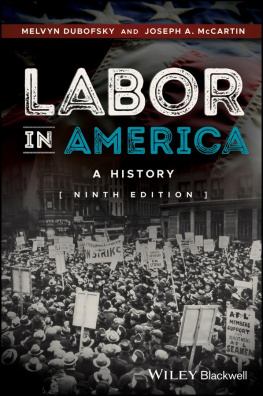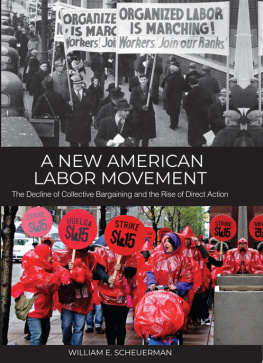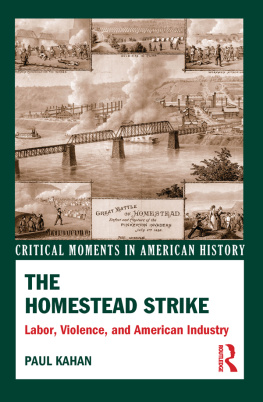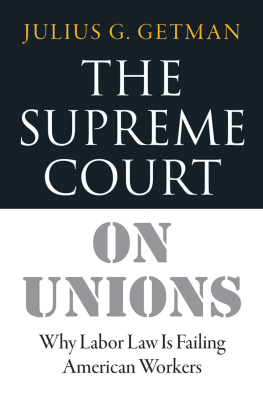Table of Contents
Guide
I would like to very much thank the staff at The New Press for their support of this project from its inception. That is especially true of my editor, Jed Bickman, who always had solid ideas on how to improve the book and didnt get too cranky when this manuscript was a little later than he would have liked. I would also like to thank my co-bloggers at Lawyers, Guns, and Money, where this book originated with my This Day in Labor History posts: Scott Lemieux, Robert Farley, David Watkins, Simon Balto, Melissa Byrnes, Dave Noon, David Brockington, Shakezula, Vacuum Slayer, Christa Blackmon, Paul Campos, Dan Nexon, and Steven Attewell. Thanks as well to Joseph Slater for teaching me so much about public sector labor over the last several years. Virginia Scharff continues to deserve more credit than anyone else for turning me into a writer and for demonstrating that a historian should write whatever they feel like writing; my debt to her cannot be fully paid. Many thanks to my colleagues at the University of Rhode Island for their support, as well as my own union director, Jay Walsh, for his leadership in our continued fight for faculty power on campus.
My parents remain the greatest supporters any child could ever hope for. I certainly wouldnt be where I am today without that support. And then there is my wife, Katie McIntyre, the best person I have ever known. Endless love to you.
Also by Erik Loomis
Out of Sight: The Long and Disturbing Story of Corporations Outsourcing Catastrophe
Empire of Timber: Labor Unions and the Pacific Northwest Forests
1. August 20, 1619First African slaves imported to Jamestown, Virginia, starting the history of slaves as the core workforce of southern plantations and creating a racialized system of work in what would become the United States.
2. October 26, 1676Nathaniel Bacon dies, effectively ending Bacons Rebellion, a revolt of largely poor whites, including former indentured servants, that helps lead Virginia planters to invest more heavily in African slaves.
3. September 9, 1739Stono Rebellion begins. In the largest slave rebellion before the American Revolution, recently imported slave warriors from Africa kill between forty and fifty whites in South Carolina before being captured and killed.
4. May 30, 1741Two slaves killed as part of New York Slave Conspiracy, a possible plan among slaves and some poor whites to burn rich peoples property in Manhattan. Although proof was sketchy, at least thirty slaves and four whites were killed over the next weeks by a white population scared of slave revolts.
5. December 10, 1789Moses Brown hires Samuel Slater to build the nations first modern textile mill in Pawtucket, Rhode Island, beginning the Industrial Revolution in the United States.
6. October 28, 1793Eli Whitney applies for a patent for the cotton gin. This technology would greatly expand slave labor in the South and provide the raw cotton for industrialization in northern states.
7. January 8, 1811German Coast uprising begins in Louisiana, a slave revolt that panicked whites and led to the brutal death of around ninety-five slaves.
8. October 26, 1825Erie Canal opens after over one thousand workers die building it, continuing the nations transformation during the Industrial Revolution and the indifference to the lives of workers.
9. August 21, 1831Nat Turners Rebellion begins in Virginia. It would result in the deaths of approximately sixty whites and nearly two hundred slaves.
10. February 13, 1837Political rally in New York City leads to the Flour Riot, an early expression of discontent over developing capitalist economy and its unfairness to working class.
11. May 10, 1837Panic of 1837 begins, leading to widespread unemployment among the northern working classes.
12. October 30, 1837Nicholas Farwells hand crushed in a railroad accident, leads to Massachusetts court ruling in 1842 that workers took on responsibility for dangerous working conditions by agreeing to work for an employer, which creates a doctrine that shelters employers from most responsibility for their unsafe workplaces.
13. February 13, 1845Lowell Female Labor Reform Association forces Massachusetts to investigate conditions in citys mills.
14. March 20, 1854Republican Party is founded, emphasizing the idea of free labor as the natural state of labor in the United States. This ideology that prioritized white men working for themselves in an economy that spread wealth around fairly equally formed its core opposition to the slave economy, but it left little room for African Americans.
15. June 23, 1855Celia, a slave in Missouri, kills her master who used her for sexual labor, a common fate for female slaves.
16. May 23, 1861Escaped slaves arrive at Fort Monroe, Virginia, fleeing to Union troops at beginning of the Civil War. General Benjamin Butler classifies them as contraband and does not return them to their masters. The beginning of the slave self-emancipation that ended American chattel slavery.
17. November 7, 1861U.S. Army occupies Sea Islands in South Carolina and begins the Port Royal Experiment to have former slaves work cotton plantations as free labor.
18. September 22, 1862President Abraham Lincoln issues preliminary Emancipation Proclamation, abolishing slavery in lands under rebellion from the United States.
19. February 23, 1864Collar Laundry Union, led by Kate Mullaney, goes on strike, leading to a rare victory for women workers in this era.
20. January 16, 1865General William Tecumseh Sherman issues Special Field Order No. 15, granting land to former slaves. President Andrew Johnson overturns it shortly after he enters the Oval Office, undermining the demands of freed slaves for land and economic emancipation.
21. February 13, 1865Sons of Vulcan, a union of iron puddlers, win the nations first union contract.
22. April 9, 1865Robert E. Lee surrenders his forces, effectively ending the Civil War with a total defeat for the South and its slave labor system.
23. November 25, 1865Mississippi institutes its Black Code, attempting to reinstitute slavery in all but name.
24. December 6, 1865Ratification of the Thirteenth Amendment, outlawing slavery in the United States.
25. August 20, 1866National Labor Union, an early federation of workers, demands Congress pass an eight-hour-day law.
26. September 18, 1873Panic of 1873 begins due to rail-road speculation, leading to widespread unemployment in northern cities. This is emblematic of the boom-and-bust economy caused by unregulated capitalism in the postCivil War era that doomed workers to poverty.
27. January 13, 1874Police crack down on workers protesting unemployment in Tompkins Square in New York.
28. June 21, 1877Ten alleged members of the Molly Maguires, an Irish secret society blamed for labor radicalism in the anthracite country of Pennsylvania, are executed.
29. July 14, 1877Great Railroad Strike begins, leading to large-scale protests against economic exploitation. President Rutherford B. Hayes orders the military to crush the strike, creating a precedent for the government to use the military to attack workers.
30. May 6, 1882Chinese Exclusion Act becomes law after California workers organize to eliminate competition from Chinese laborers.
31. March 1, 1886Great Southwest Railroad Strike begins, as the Knights of Labor, the nations first broad-based labor organization, expands its reach across the nation. The ability of the railroad capitalist Jay Gould to put down the strike marked the beginning of the Knights decline.
Next page





